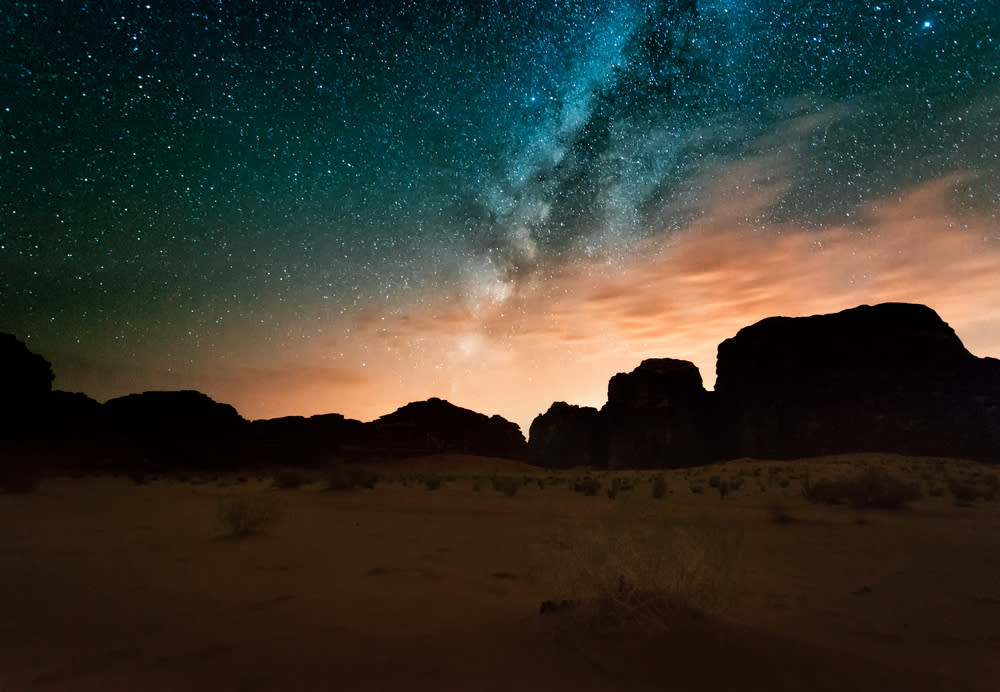
Wadi Rum
21° 70°
Your Time: Time in Wadi Rum: 05:55
5:00 AM, Fri 25th Apr
-
Temp feels like21°C70°F
-
Length of day13h 10m
-
Pressure29" (1012 hpa)
-
Visibility6 km (3miles)
-
Wind speed18 km/h
Sunrise 06:03
Sunset 19:13
-
Temp feels like:
21ºC (70 ºF)
-
Length of day:
13h 10m
-
Pressure:
29" (1012 hpa)
-
Visibility:
3 miles (6 km)
-
Wind speed:
18 km/h
Also known to many as The Valley of the Moon, Wadi Rum is as exotic as its name sounds. A spectacularly scenic desert located in the south of Jordan, Wadi Rum is an untouched place with imposing rock skyscrapers that have been carved by years of wind and weather.
Wadi Rum means 'high' or 'elevated' in Aramaic. It is a valley formed into sandstone and granite rock with monolithic rock spaces that rise from the hot desert ground, reaching up to 1750m in height, prompting serious mountaineers to scale its elegant length. The highest elevation in Wadi Rum is Mount Um Dami at 1840m followed by Jabal Rum at 1734m.
A good way to explore Wadi Rum is by booking a 4x4 vehicle with a guide at the Visitor's Centre. From there, it's a two to three hour drive to explore Wadi Rum's best known sites; one of which is the Khazali Canyon, where visitors can see petro glyphs dating back to the Thamudic times. For the more adventurous, there's always the option of travelling the Bedouin way, which is by camel.
Wadi Rum is a dry landscape of barren desert, sand dunes and hot sun, so comfortable, appropriate clothing is highly essential due to the terrain and the climate. Also, seeing as you will likely be on the back of a camel back or a 4x4 at some point, practical gear is a sensible option.
Climate
Though Jordan is a Mediterranean climate making it pleasant all year round, Wadi Rum is a desert climate where temperatures can soar severely. The best time to visit Wadi Rum is from March to May and September to November. Wadi Rum shares a fairly similar climate with that of Aqaba, Eilat and Taba. The high variation of daily temperature depends on the time of the year. Summertime temperatures range from 45°C to 48°C, whereas nighttime temperatures can go down to 15°C. During winter months, though there is no snow or ice, temperatures during the day can be at 20°C and night time temperatures can get down to 5°C. Wadi Rum experiences at least 12 hours of sunlight every month and the annual precipitation is low where it can be between 50 to 100mm.
Summer
During the summertime, sightseeing or even walking in Wadi Rum can be very uncomfortable. During these times, tours or walkabouts normally take place at 5pm onwards, otherwise visitors can suffer sunstroke or get sunburned without proper clothing and protection. As well as for protection from the elements, visitors are advised to respect the local culture and dress modestly at all times. Heat wise, the end of March to the middle of May is generally more pleasant.
Rain is also frequent during this time, though it tends to occur more toward winter months. The hotter months bring a weather condition called 'khamsin', which basically means dry, hot and dusty wind blowing from the Arabian Peninsula. Dehydration risks are pretty high during the hot months, so listen to your tour guides' advice on when to go out and what to wear.
Winter
Winter time generally begins at the end of November and temperatures can get very cold at nighttime. It can sometimes freeze at night, so also remember to bring a warm, waterproof jacket as rain can strike at anytime. Wadi Rum receives most rainfall during the winter months. It has been known to snow in the mountains but the snow quickly disappears as the day progresses and the sun becomes hotter.
During winter months, temperatures drop to 21°C and gradually go up as the months pass. Nighttime temperatures can dramatically drop down to 15°C. These vast differences between day and nighttime temperatures happen throughout the year.
Sandstorms
Because the weather is dry and the area is sandy, sandstorms are frequent. Visitors are advised to wear covered clothing, to not only protect themselves from rain and the hot sun, but also to cover their body from these sandstorms. Head covers like those worn by the Bedouin tribes are a good option.
Conservation
Since Wadi Rum is a World Heritage Site, conserving the area is of utmost importance to the people of Jordan and Wadi Rum. Tour operators and tourism agencies request visitors and tourists to follow the guidelines and policies outlined to ensure minimal carbon footprints are left after leaving the site.
Natural disasters and terrorism
Jordan is relatively a peaceful country, though it is prone to terrorist attacks and other political insecurity as it shares borders with Syria, Iraq, Saudi Arabia and Israel. The latest issues connected to terrorism took place on 21 October 2012 when the Jordanian government foiled a terrorist plot in Amman. Other past concerns happened in 2010 when a rocket landed close to the Intercontinental Hotel in Aqaba, and in January 2010, when a roadside explosion occurred near the village of Na'ura.
Apart from terrorism, Jordan is also at risk of earth tremors. The most recent one occurred in December 2010 after an earthquake measuring 3.5 on the Richter scale struck off at the epicentre of the Dead Sea.
Before travelling to Wadi Rum or Jordan, read up on the current situation of the country. Doing your homework will help you prepare yourself for the location's climate, as well as its political situation.
















